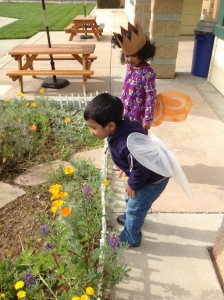Bee Curious

Originally appears in the Spring 2015 issue
“Why are bees in the flowers?”
Countless children have asked me this question. With each child, I squat down next to them, slip my glasses down my nose, lift the brim of my hat, widen my eyes, and say, “I wonder about that.” Often there is a long pause as the child expects an explanation. Then I say, “Tell me what you think. What do you notice?”
The small purple thyme flowers in the landscaping around the sandpits at Harker Preschool are a favorite of honeybees. The children make amazing observations of these busy insects while outside at play. That pause in play—to wonder at the flight of a bee or at its milling about in a flower—this is powerful science. Not just any kind of science, this is inquiry-based science because it is driven by innate curiosity.
Young children are natural scientists because they want to understand the world around them. By levering their curiosity, I am able to extend something they wonder about into an investigation. You might ask me, “Why not simply read them a book that tells about bees and bee behavior?” It is a fair question. Certainly, I referenced many books about bees in our honeybee investigation. But the primary way the young child learns is through imitative play. She needs to be the bee!
This content is restricted to subscribers only.
If you are not yet a subscriber, please consider taking out a subscription here.
If you are an existing subscriber, kindly log in or contact us at info@greenteacher.com for more information.





